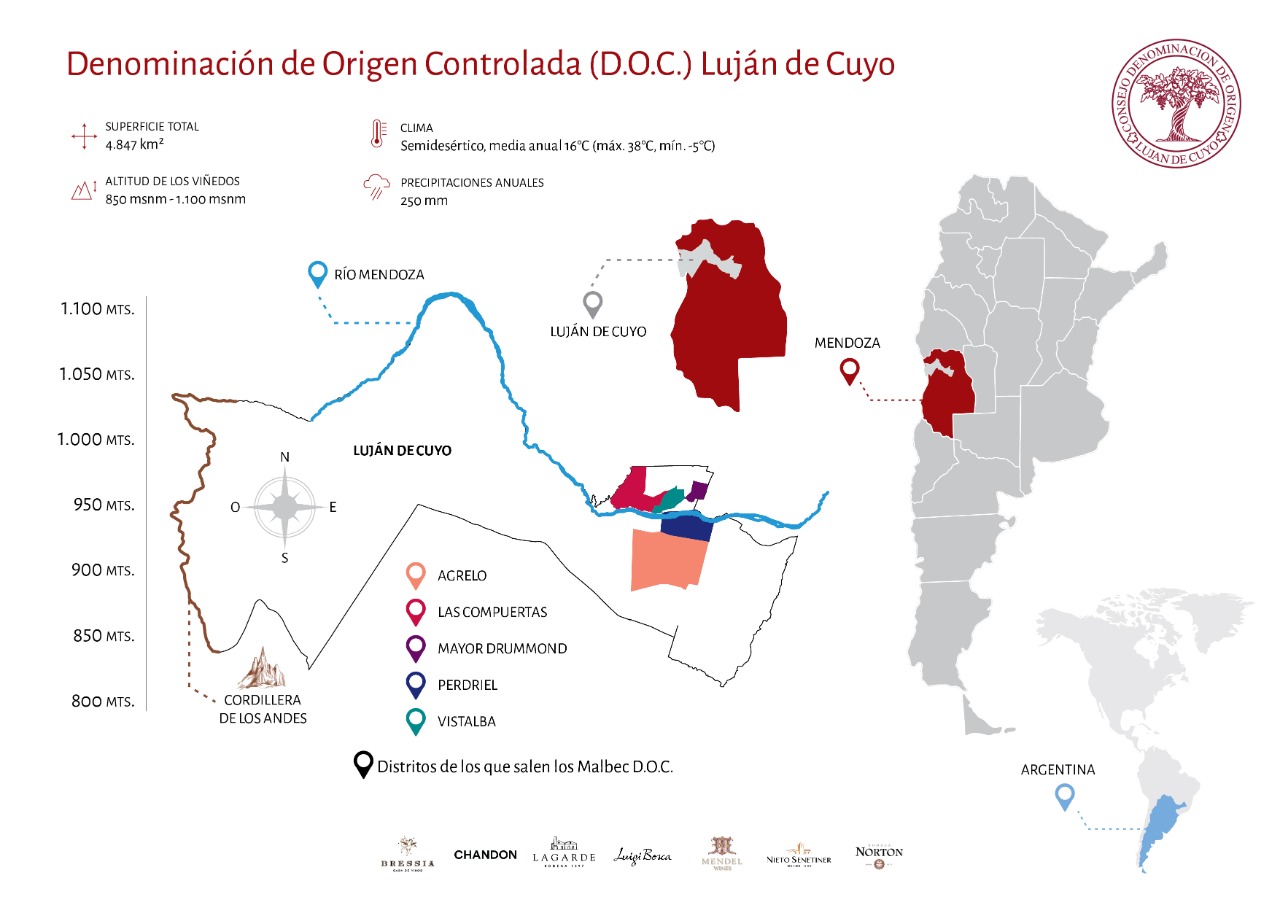Blog - General
Lujan de Cuyo´s D.O.C. looks to the future
Lujan de Cuyo´s controlled designation of origin, which exists since 1989 and has been a national law since 1999, renewed its authorities, its regulations and, for the first time since its origin, added two new wineries: Bressia and Mendel. Now the number of wineries that make up Lujan de Cuyo´s D.O.C. are seven: Bressia, Chandon, Lagarde, Luigi Bosca, Mendel, Nieto Senetiner and Norton.
Lujan de Cuyo´s controlled designation of origin council was founded by winegrowers and winemakers of the region in order to protect, promote and disseminate the characteristic red capped mainly made up of the Malbec variety. One of the main promoters of the initiative was Alberto Arizu (father), who chaired the council from its creation until last April, when new authorities were appointed.
This new era includes a renewal of the official regulations, the development of a strategic plan to position Malbec from Lujan de Cuyo more strongly in the local and international markets and open the possibility for more producers and wineries to join the D.O.C. in the future. These strategic points are the result of more than a year of interdisciplinary work, which continues through the permanent research and development of the council.
The new council has been organized in the following way: Roberto de la Mota (president); Pablo Cúneo (secretary); Walter Bressia (treasurer); Roberto González (titular member); David Bonomi (regular account auditor); Sebastián Barboza (alternate auditor) and Alberto Arizu (honorary chairman of the board).
“Those who created Lujan de Cuyo´s D.O.C. were truly visionaries and ahead of their time. It is essential to recognize those who worked and currently work in this controlled designation of origin with a supreme interest in preserving and enhancing the old vineyards of Lujan de Cuyo. The fact that there is a D.O.C. protects producers, since it prioritizes the area where their crops are located; the Argentine cultural patrimony, preserving and putting in value old vineyards, and the consumer, who is guaranteed the quality and identity of the product acquired”, explained Roberto de la Mota, president of the council.
The prestige of the wines that are part of this appellation is due not only to the proven quality standard of the wines that come from Lujan de Cuyo´s terroir but also to the outstanding characteristics they possess, such as elegance, smoothness, roundness and fruit.
Currently, the wines of the Lujan de Cuyo´s D.O.C. have a significant presence in international markets (more than 40 countries), with Brazil and the United States being the main destinations for Malbec D.O.C. Sales in the local market continue with a positive trend and the projections are sustainable, with a very optimistic sales scenario.
¿What is a D.O.C.?
A controlled designation of origin is the name that identifies the products originating in a region, whose particular qualities are due to the geographical environment, which includes both natural and human factors that generate their production. Lujan de Cuyo´s D.O.C. was the first one created in America.
This council is based on the free and voluntary association of winegrowers and winemakers of fine wines of the region, who mutually take advantage of the specific ecological characteristics and the vines that distinguish Lujan de Cuyo´s geographical area, allowing them to obtaining quality products that can be perfectly distinguished from others produced under different natural conditions.
The Groundwork
It all started with the first soil studies carried out by the INTA programs, which researched the geographic identification and the viticultural and oenological aptitude of the crops. It was a joint venture between public and private entities that took several Europeans AOC´s as a guide.
In 1988 the bases and guidelines were established between the main companies of Lujan de Cuyo, in 1990, the official recognition came (Law 3086) and in 1999, National Law 25,163 was enacted, in order to establish a system for the recognition, protection and registration of the Argentine geographical names. From that moment on, the following categories of designation were established: Indication of Origin (I.P.), Geographical Indication (I.G.) and Controlled Designation of Origin.

The wines that have the right to bear the D.O.C. acronym on their label must comply with strict requirements concerning vineyard; workmanship and quality. The certification is endorsed by the wafer issued by the council and carried by the approved wines. This is done with the endorsement of the National Institute of Viticulture (INV), which carries out the controls regarding compliance with the Law.
The DNA of Lujan de Cuyo´s D.O.C.
• Lujan de Cuyo grapes (approved by the council);
• Estate produced and bottled;
• Vineyards with a minimum age of 10 years, trellis and a density of more than 5,000 plants per hectare;
• Low yield limited per hectare;
• Malbec variety (85% minimum and 15% remaining varieties authorized by the regulation);
• Minimum alcohol content: 13.5%;
• Aging: 18 months between harvest and market release, with a minimum of 6 months of aging in wood;
• Regulated labeling and numbered official wafer to guarantee traceability;
• Permanent supervision of the council and the INV for compliance with the Regulation through technical commissions in the vineyard, winery and product evaluation;
• Additional technical requirements contemplated in the Board Regulations.











